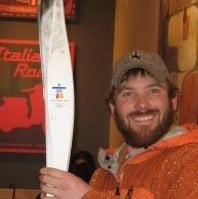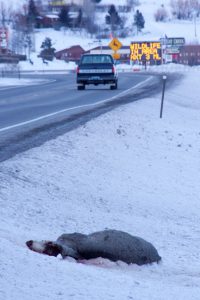President’s Message
Winter 2018
Message from the President, Ben Wise
What a difference a year makes…
As I sit looking out my window in Jackson, I can’t help but think of what a difference a year makes. Last year at this time western Wyoming was in the grasp of one of the most severe winters ever recorded, resulting in unprecedented wildlife mortality. Mule deer, having migrated from the high elevations of the Wyoming and Gros Ventre Ranges, arrived on winter range with snow packs in some locations up to 200% of average. In much of these winter ranges it would not be until late spring, once winter snows subsided, that folks were able to get out on the ground and verify the true toll of the winter severity; in other areas the effects were much more apparent and instantaneous…
Wildlife Vehicle Collisions (WVC) are a major cause of wildlife mortality throughout the state and result in millions of dollars in property damage every year in Wyoming. In an effort to curtail WVC, a grass roots collation of sportsmen, conservationists, wildlife managers, transportation officials, and lawmakers gathered in Pinedale last spring for the Wildlife & Roadways Summit to brainstorm solutions to these complex issues. It was quickly realized that throughout most of the state, wildlife professionals have been compiling wildlife movement data and were identifying areas of increased WVC or “hot spots,” but without an adequate, reliable funding source many of these problem areas had little to no chance of being addressed. Out of these discussions came WY HB0039, sponsored by Representative Stan Blake. This bill, if passed*, would create a Wyoming Wildlife License Plate. Dollars generated from the sale of these plates would be put into a WYDOT account specifically to be used for the construction of crossing structures, fence modifications, and increased signage in an effort to reduce vehicle related mortality on Wyoming’s roads.
Realistically, the revenue generated from the sale of these license plates will be but a pittance compared to the total amount of money required for getting large scale projects off the ground, but it is a start. More than anything, it allows the citizens of Wyoming the opportunity to reinvest in their wildlife resource. The fact that a small, grass roots group of individuals were able to identify an issue, come to a consensus, set a course to develop a solution, and (hopefully) garner enough support to achieve a shared goal is inspiring.
The take home message from all this is that where there is a will, there is a way. Solutions can be found for even the most daunting and insurmountable circumstances when people come together and coalesce around a shared goal. Whether or not this bill will end up gaining enough support to become law has yet to be seen, but as long as passionate conservationists are willing to step up and speak out on behalf of our wildlife, a funding mechanism to begin addressing WVC’s may truly become a reality.
*UPDATE: On February 27, the bill was passed by the House. On March 8, it passed the through the Wyoming Senate, and is heading to the Governor’s desk to be signed.
 Ben Wise is the Jackson Regional Brucellosis-Feedground-Habitat (BFH) Biologist for the Wyoming Game and Fish Department (WGFD). He is tasked with working to reduce the risk of transmission of communicable wildlife diseases (primarily Brucellosis) both inter- and intra-specific through adaptive feedground management, habitat treatments, and disease research.
Ben Wise is the Jackson Regional Brucellosis-Feedground-Habitat (BFH) Biologist for the Wyoming Game and Fish Department (WGFD). He is tasked with working to reduce the risk of transmission of communicable wildlife diseases (primarily Brucellosis) both inter- and intra-specific through adaptive feedground management, habitat treatments, and disease research.



